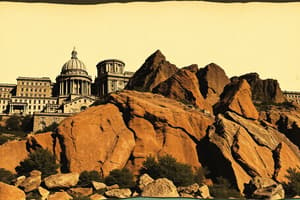Podcast
Questions and Answers
Which of the following best explains the concept of 'deep time' as proposed by James Hutton?
Which of the following best explains the concept of 'deep time' as proposed by James Hutton?
- The concept that Earth is immensely old, with geological processes operating over extremely long timescales. (correct)
- The idea that evolution occurs rapidly over short periods, leading to significant changes in species.
- A geological theory suggesting that Earth's features were formed suddenly by catastrophic events.
- A biological principle that describes how organisms adapt to their environment within a single generation.
According to Charles Lyell's theory of uniformitarianism, which statement best reflects his view of geological processes?
According to Charles Lyell's theory of uniformitarianism, which statement best reflects his view of geological processes?
- Past geological processes were less intense and operated at a slower rate than those observed in modern times.
- Earth's geological features are primarily shaped by sudden, catastrophic events that are different from processes seen today.
- Supernatural forces played a significant role in shaping Earth's geological features in the distant past.
- The processes shaping Earth today, such as erosion and volcanic activity, are the same as those that operated in the past. (correct)
Lamarck's hypothesis of inheritance of acquired characteristics was ultimately proven incorrect, but what was its main premise?
Lamarck's hypothesis of inheritance of acquired characteristics was ultimately proven incorrect, but what was its main premise?
- Traits acquired during an organism's lifetime through use or disuse of body parts are inheritable. (correct)
- Species remain unchanged over time, and there is no mechanism for adaptation or evolution.
- Environmental pressures have no impact on an organism's traits or its ability to pass them on to offspring.
- Organisms change randomly over time, and these changes are passed on to subsequent generations by chance.
In the context of natural selection, what is the significance of 'fitness'?
In the context of natural selection, what is the significance of 'fitness'?
How does artificial selection differ from natural selection?
How does artificial selection differ from natural selection?
What does the phrase 'survival of the fittest' truly represent in evolutionary terms?
What does the phrase 'survival of the fittest' truly represent in evolutionary terms?
How does gene flow affect the genetic variation within a population?
How does gene flow affect the genetic variation within a population?
What is the primary cause of genetic drift?
What is the primary cause of genetic drift?
What is the bottleneck effect, and how does it impact genetic diversity?
What is the bottleneck effect, and how does it impact genetic diversity?
How does the founder effect differ from the bottleneck effect in terms of their causes?
How does the founder effect differ from the bottleneck effect in terms of their causes?
What are homologous structures, and what do they suggest about evolutionary relationships?
What are homologous structures, and what do they suggest about evolutionary relationships?
How do analogous structures differ from homologous structures, and what do they indicate?
How do analogous structures differ from homologous structures, and what do they indicate?
What are vestigial structures, and why are they considered evidence of evolution?
What are vestigial structures, and why are they considered evidence of evolution?
How does the field of embryology support the theory of evolution?
How does the field of embryology support the theory of evolution?
What is the likely effect of an ice age glacier covering a large portion of a species' habitat?
What is the likely effect of an ice age glacier covering a large portion of a species' habitat?
What does it mean for a species to vary globally?
What does it mean for a species to vary globally?
What must be true in order for a species to vary locally?
What must be true in order for a species to vary locally?
Which of the following is a result of emmigration?
Which of the following is a result of emmigration?
Within the concepts of natural selection, how do environmental factors contribute?
Within the concepts of natural selection, how do environmental factors contribute?
Which of the following is the best example of species varying over time?
Which of the following is the best example of species varying over time?
Flashcards
Evolution
Evolution
The process of change in living organisms over time.
Species Variation
Species Variation
Species vary globally, locally, and over time, showing different adaptations based on habitat and time.
Deep Time
Deep Time
The concept that Earth is immensely old, allowing for gradual geological changes.
Uniformitarianism
Uniformitarianism
Signup and view all the flashcards
Natural Selection
Natural Selection
Signup and view all the flashcards
Adaptation
Adaptation
Signup and view all the flashcards
Fitness
Fitness
Signup and view all the flashcards
Influences on Fitness
Influences on Fitness
Signup and view all the flashcards
Survival of the Fittest
Survival of the Fittest
Signup and view all the flashcards
Gene Flow
Gene Flow
Signup and view all the flashcards
Genetic Drift
Genetic Drift
Signup and view all the flashcards
Bottleneck Effect
Bottleneck Effect
Signup and view all the flashcards
Founder Effect
Founder Effect
Signup and view all the flashcards
Homologous Structures
Homologous Structures
Signup and view all the flashcards
Analogous Structures
Analogous Structures
Signup and view all the flashcards
Vestigial Structures
Vestigial Structures
Signup and view all the flashcards
Embryology
Embryology
Signup and view all the flashcards
Study Notes
- Evolution is the process of change over time in living organisms
Darwin and the HMS Beagle
- Charles Darwin traveled the world on the ship HMS Beagle, making key observations that led to his theory of evolution
Species Variation
- Species vary globally, locally, and over time
- Globally: Similar species inhabit similar habitats on different continents (ostrich, rhea, emu)
- Locally: Different species inhabit different habitats within the same area (Galapagos finches)
- Over Time: Extinct species are similar to living species in the same area (Glyptodont and armadillo)
Hutton and Deep Time
- James Hutton proposed the concept of "deep time"
- Deep time describes the immense age of the Earth, far beyond human comprehension
- Evidenced by slow geological processes like erosion and sedimentation
Lyell and Uniformitarianism
- Charles Lyell's theory of uniformitarianism: geological processes that shaped the Earth in the past are the same as those occurring today
- Examples: Volcanoes releasing lava and gases now are similar to ancient volcanoes
Lamarck's Hypothesis
- Lamarck believed that using or not using body parts could make them larger or smaller
- He also thought that parents could pass these acquired traits to their offspring, causing species to change
- Lamarck's ideas are incorrect
Natural Selection
- Natural selection: Organisms with traits best suited to their local environment survive, reproduce, and pass on their genes
- Adaptation: A heritable characteristic that increases an organism's ability to survive and reproduce
Fitness
- Fitness is an organism's ability to survive and reproduce in its environment
- High fitness: Adaptations well-suited to the environment
- Low fitness: Characteristics that decrease survival and reproduction
Influences on Fitness
- Environmental pressures drive natural selection
- Human choice drives artificial selection
Natural Selection Concepts
- Struggle for existence: Organisms compete for limited resources
- Variation of traits: Individuals within a population have different traits
- Survival of the fittest: Individuals with advantageous traits are more likely to survive and reproduce
Big Picture of Evolution
- Changes in the environment can affect the variation of traits
- High-fitness traits lead to survival
- Genes for advantageous traits are passed on to future generations
Survival of the Fittest
- "Survival of the fittest" means the survival and reproduction of organisms best adapted to their specific environment
Gene Flow
- Gene flow: The movement of alleles (gene versions) between populations
- Emigration: Leaving a population and removing genes from that population
- Immigration: Joining a new population and adding genes to that population
Genetic Drift
- Genetic drift: Random changes in allele frequencies due to chance
- Genetic drift causes a loss of genetic diversity
- Genetic drift is most impactful in small populations
- Founder effect and bottleneck events are processes cause genetic drift
Bottleneck Effect
- The bottleneck effect is when a population's size is reduced drastically due to a natural disaster, habitat loss, or overhunting
Founder Effect
- The founder effect is when a few individuals start a new population with different resources and pressures
Homologous Structures
- Homologous structures: Structural features with a common evolutionary origin but potentially different functions
- Homologous structures are evidence of evolution
Analogous Structures
- Analogous structures: Parts of organisms that look similar but do not share a common ancestor
- Similar function, but not structure
Vestigial Structures
- Vestigial structures: Structures in an organism that no longer serve their original purpose EX) appendix and wisdom teeth
Embryology
- Vertebrate embryos share structural similarities
- There is little selective pressure in the womb so there is no reason to change developmental patterns when basic organ systems are being layed out
Population Bottleneck Example
- An ice age glacier covering the northern hemisphere would create a population bottleneck
Studying That Suits You
Use AI to generate personalized quizzes and flashcards to suit your learning preferences.




